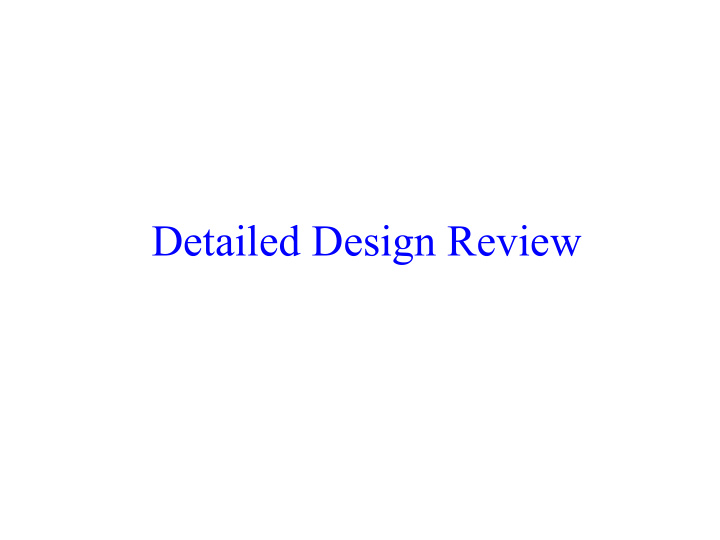



Detailed Design Review
Key Objectives? • Catch mistakes and improve design • Verify readiness to spend money and build prototype: – Specs (needs) are addressed − Risks are addressed
Participants? • Guide, TA, and all team members • People who can help you satisfy your objectives – Expertise in each area (and from each discipline) that will be reviewed – Challenge your design and your assumptions – Attendance may change with agenda
Preparation • Your expectations and critical focus areas • Design input – specifications – Complete, unambiguous, testable – Traceable to customer needs, systems architecture, and test plan
Preparation • Design output – evidence that design will meet specs (through inspection, analysis, or reference to something proven) – System architecture – subsystems address all specs (concept update may be helpful) – Detailed drawings, schematics, flow charts – everything needed to physically and functionally realize your design, from component to subsystem to system
Example design documents by discipline • ME: 3D CAD drawings, mechanical simulations • EE / CE: final ORCAD schematics, detailed SPICE, Matlab simulations. • ISE: factory layout, process flow diagrams, workflow maps, supply chain maps, ergonomic drawings, lean analysis, inventory analysis, coupled with implementation plans • All: step-by-step plan to fully characterize system against all specs
Preparation • Design output (…continued) – Feasibility analysis – simulations, engineering analysis, prototyping (if appropriate) • Evidence that your design will work • Focus on technically challenging (high risk) areas – BOM – long lead items and vendors identified, review against budget
Preparation • Preliminary test plans – evidence that your design does work • Updated risk assessment • Agenda with timeline by discipline • Distribute as much as possible before the review • Review prior project documentation • PRACTICE!!
Postulate Questions Will customer needs be satisfied as defined/measured by target values (specs)? Function Will the architecture and functions be fulfilled? Will they produce the desired effects? What other supporting functions are needed? Layout, geometry Will the chosen layout, component shapes, materials, and dimensions provide adequate & materials robustness, adequate durability, permissible deformation, adequate stability, impact resistance, unimpeded expansion and heat transfer? Energy & Will the chosen layout and components provide acceptable transfer of energy, adequate transient kinematics and steady state behavior, and appropriate motion, velocity, and acceleration profiles? Safety Have all factors affecting the safety of the user, components, functions, operations, and the environment been taken into account? Ergonomics Have human-machine relationships been fully considered? Have unnecessary human stress or injurious factors been predicted and avoided? Has attention been paid to aesthetics and the intrinsic “feel” of the “product”? Quality control Have standard tolerances been chosen (not too tight)? Assembly Are assembly operations defined and can they be performed simply, repeatedly, and without ambiguity? (not due yet) Operation Have all factors influencing operation (such as noise, vibration, handling) been considered? Costs Will stipulated cost limits be observed? Will additional operational costs arise? Schedules Will delivery dates be met? What design modifications might reduce cycle time and improve delivery?
Test Plans • Documents how you are going to verify satisfaction of specs – how to test the features and functions that constitute your design implementation • Important components: – What you’ll test (and what you won’t test) – How you’ll test: equipment and materials needed, test configurations and procedures, pass/fail criteria – Responsibilities and the approval process – Risks and contingencies • See mycourses for more detailed format, links to samples, and a template • Preliminary plan now, finalize early next quarter
Logistics • 2-hour block scheduled, but may need multiple reviews • Invite participants in advance and distribute materials; highlight times for specific attendees • All material on laptop, hardcopy of appropriate documentation • Discussion format – focus on improving design and catching problems • Allocate time to most critical areas • PM manages agenda, team members responsible for sections • Document action items, issues, decisions (see templates) • Update EDGE with notes and all design documents
Recommend
More recommend